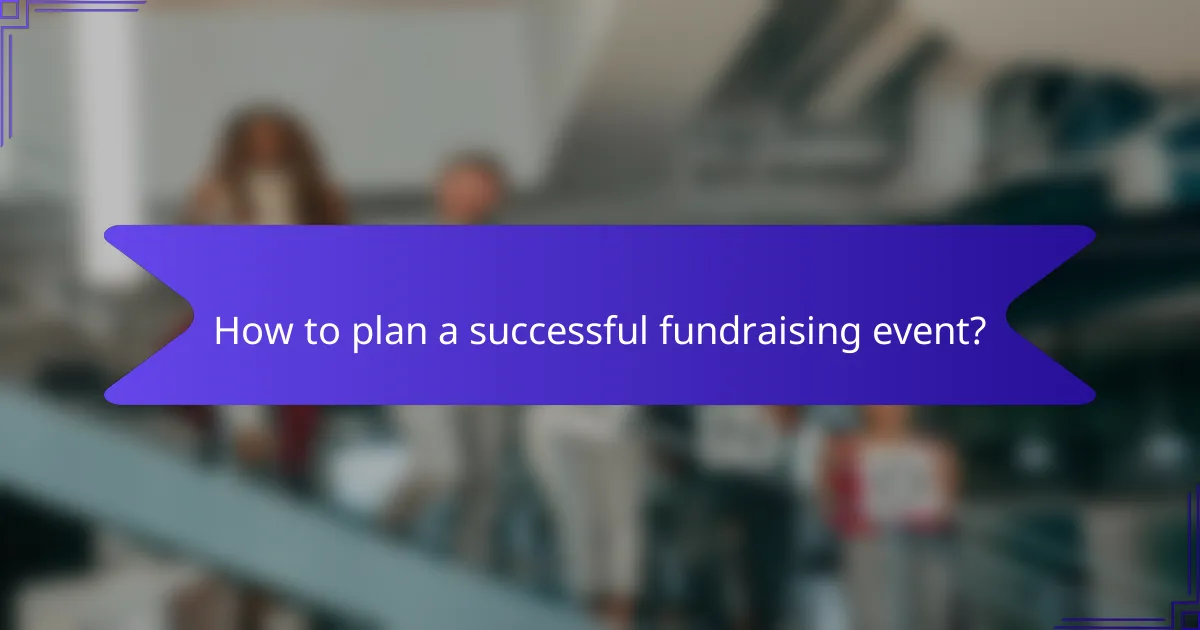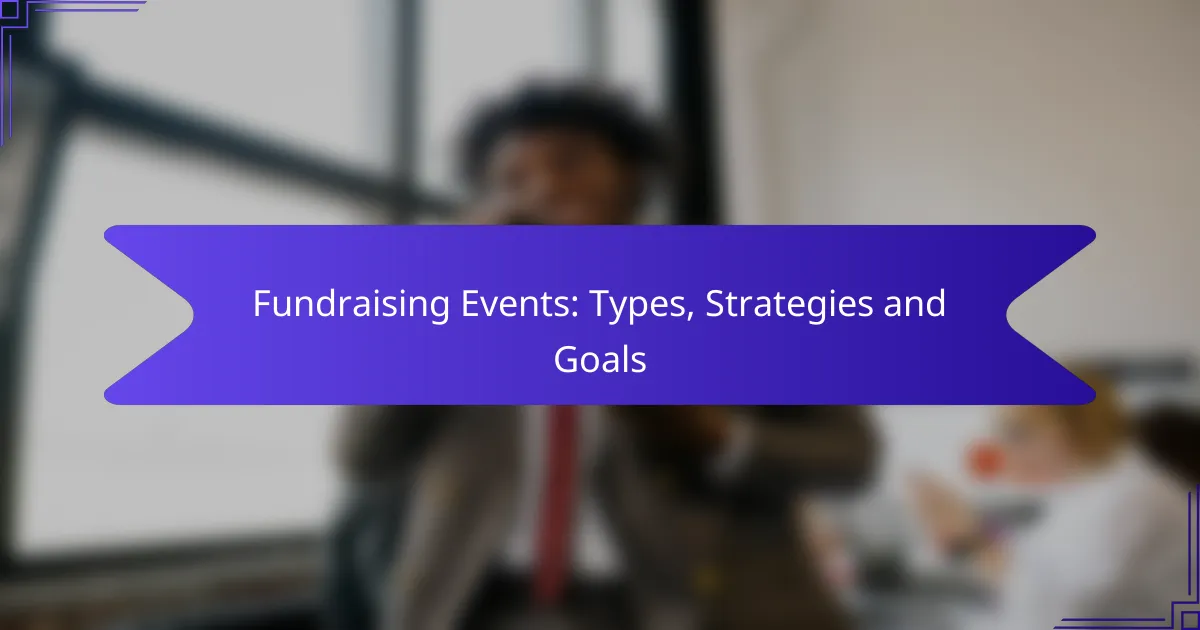Fundraising events play a crucial role in supporting various causes, offering diverse formats such as charity auctions, fun runs, and gala dinners to engage different audiences. Successful planning involves establishing clear objectives, choosing the right venue, and employing effective marketing strategies to enhance participation and donations. By utilizing targeted fundraising strategies, organizations can foster emotional connections with potential donors and create meaningful opportunities for contribution.

What types of fundraising events are popular in the United States?
In the United States, popular fundraising events include charity auctions, fun runs and walks, gala dinners, online crowdfunding events, and concerts and performances. Each type offers unique opportunities for engagement and revenue generation, appealing to different audiences and donor preferences.
Charity auctions
Charity auctions involve bidding on items or experiences donated by individuals or businesses, with proceeds going to a specific cause. These events can be live, silent, or online, allowing flexibility in how they are conducted.
To maximize success, ensure that the items are appealing and relevant to your audience. Consider starting bids low to encourage participation and create excitement. Promote the event widely through social media and email campaigns to attract bidders.
Fun runs and walks
Fun runs and walks are engaging events that encourage physical activity while raising funds for a cause. Participants typically pay a registration fee, and additional funds can be raised through sponsorships and donations.
To organize a successful fun run, choose a scenic route and provide incentives for participants, such as t-shirts or medals. Promote the event through local community channels and social media to attract a diverse group of participants.
Gala dinners
Gala dinners are formal events that combine dining with fundraising activities such as auctions or raffles. These events often attract high-net-worth individuals and can generate significant contributions.
When planning a gala dinner, select an appealing venue and create a compelling program that includes entertainment and guest speakers. Ticket prices should reflect the exclusivity of the event, and consider offering sponsorship opportunities to cover costs and enhance fundraising potential.
Online crowdfunding events
Online crowdfunding events leverage digital platforms to raise funds for specific projects or causes. Participants can contribute small amounts, making it accessible for a wider audience.
To run a successful online crowdfunding campaign, set a clear financial goal and timeline. Use engaging storytelling and visuals to connect with potential donors. Promote the campaign across social media and email to reach a broad audience and encourage sharing.
Concerts and performances
Concerts and performances can serve as entertaining fundraising events, where ticket sales and donations contribute to a cause. These events can feature local artists or well-known performers, depending on budget and audience appeal.
When organizing a concert, choose a venue that fits the expected audience size and atmosphere. Collaborate with local artists to reduce costs and promote the event through various channels to maximize attendance and donations.

How to plan a successful fundraising event?
Planning a successful fundraising event involves setting clear objectives, selecting an appropriate venue, and implementing effective marketing strategies. By focusing on these key areas, you can maximize participation and donations.
Set clear goals
Establishing clear goals is essential for guiding your fundraising event. Determine the amount of money you aim to raise, the specific cause you are supporting, and the target audience you want to engage.
Consider using the SMART criteria: goals should be Specific, Measurable, Achievable, Relevant, and Time-bound. For example, instead of a vague goal like “raise money,” aim for “raise $5,000 for local animal shelters within three months.” This clarity helps in planning and measuring success.
Choose the right venue
Selecting the right venue is crucial for the success of your fundraising event. Consider factors such as location, capacity, accessibility, and amenities. A well-chosen venue can enhance the experience for attendees and encourage participation.
For example, a community center might be suitable for a local charity event, while a more upscale venue could be appropriate for a gala. Ensure the venue aligns with your event’s theme and budget, and book it well in advance to secure your preferred date.
Develop a marketing strategy
A strong marketing strategy is vital for attracting attendees and donors to your fundraising event. Utilize various channels such as social media, email newsletters, and local press to promote your event effectively.
Consider creating engaging content that highlights the cause and the impact of donations. Use visuals, testimonials, and countdowns to build excitement. Additionally, set a timeline for your marketing efforts, starting several weeks before the event to maximize reach.
Engage volunteers and sponsors
Volunteers and sponsors play a key role in the success of fundraising events. Recruit volunteers early to assist with planning, setup, and day-of tasks. Their enthusiasm and support can significantly enhance the event experience.
For sponsorship, identify local businesses or organizations that align with your cause. Offer them visibility during the event in exchange for their support, such as logo placement or speaking opportunities. Building these partnerships can increase resources and credibility for your event.

What are effective fundraising strategies?
Effective fundraising strategies are methods that organizations use to raise money for their causes. These strategies can vary widely but often focus on engaging potential donors, creating emotional connections, and providing clear avenues for contribution.
Utilizing social media campaigns
Social media campaigns are powerful tools for reaching a broad audience quickly. By creating engaging content and utilizing platforms like Facebook, Instagram, and Twitter, organizations can raise awareness and encourage donations.
To maximize impact, consider using targeted ads and hashtags to reach specific demographics. Regular updates and interactive posts can keep your audience engaged and motivated to contribute.
Creating compelling storytelling
Compelling storytelling connects potential donors emotionally to your cause. Sharing personal stories about the impact of donations can inspire individuals to give, as they see the real-world effects of their contributions.
Utilize various formats, such as videos, blog posts, or infographics, to tell your story. Highlight specific beneficiaries and outcomes to make your narrative relatable and memorable.
Leveraging peer-to-peer fundraising
Peer-to-peer fundraising involves supporters raising money on behalf of your organization. This strategy expands your reach by tapping into the networks of your supporters, making it a cost-effective way to boost donations.
Encourage participants to set personal fundraising goals and provide them with tools and resources to share their campaigns. Recognizing and rewarding top fundraisers can also motivate others to participate.
Offering tiered donation options
Offering tiered donation options allows donors to choose their level of contribution, making it easier for them to participate. This approach can cater to various budgets, encouraging both small and large donations.
Consider creating specific benefits for each tier, such as exclusive content or recognition on your website. This strategy not only incentivizes higher donations but also fosters a sense of community among supporters.

What are the goals of fundraising events?
The primary goals of fundraising events are to generate financial support for a cause, raise awareness, and foster community involvement. These events can serve multiple objectives simultaneously, making them versatile tools for non-profits and organizations.
Raising awareness for a cause
Fundraising events are effective platforms for raising awareness about specific issues or causes. By engaging participants and attendees, organizations can share information, stories, and the impact of their work, which helps to educate the public.
Consider using visual elements, such as banners or videos, to highlight the cause. Social media promotion before and after the event can further amplify the message, reaching a broader audience.
Building community engagement
Community engagement is a vital goal of fundraising events, as they create opportunities for individuals to connect over shared interests. These events can foster relationships among participants, volunteers, and supporters, strengthening the community’s bond with the cause.
To enhance engagement, consider incorporating interactive elements like workshops, discussions, or team challenges. This involvement can lead to increased volunteerism and support for future initiatives.
Generating recurring donations
One of the key objectives of fundraising events is to encourage recurring donations. By showcasing the impact of contributions during the event, organizations can motivate attendees to commit to ongoing support.
Implement strategies such as membership programs or subscription-based giving to facilitate recurring donations. Offering incentives, like exclusive updates or recognition, can also encourage donors to contribute regularly.
